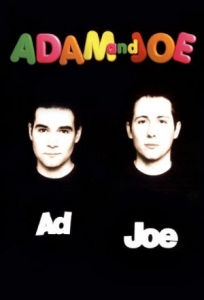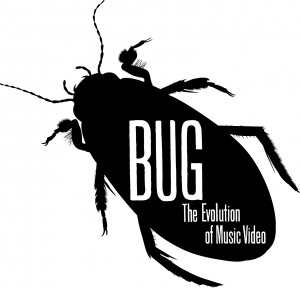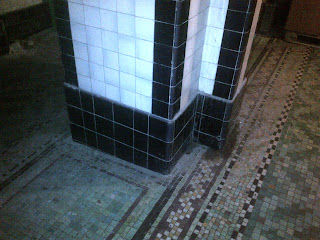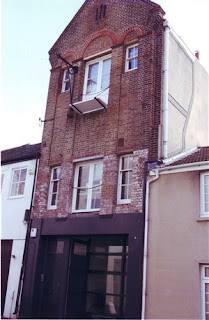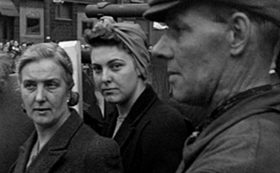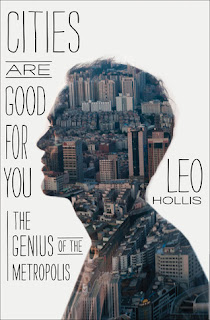Many years ago I attended a series of events showing seminal music videos on the big screen at the NFT in London (now the BFI). I always wondered why this did not happen more often, particularly now no-one watches videos on TV anymore.
Seemingly Adam Buxton of Adam and Joe fame, now on BBC Radio 6 Music, had the same idea and unbeknownst to me has been running a series called BUG doing just that at the BFI. Go figure.
I was therefore very excited to see that Buxton would be presenting a BUG special on Fatboy Slim Bug at the Brighton Fringe and booked my ticket immediately expecting a sellout (what with Norman Cook being a Brighton local).
A week before the event it was announced that Norman Cook would actually be in attendance and on the stage!
The event was held in the Dome, a vast semicircular performance space, so we were given a 15 minute call to take our seats. The adrenalin was already beginning to rise as the room as filled with a pulsing dance beat and the big screen showed a continuous shot of Buxton's face as he cycled through the streets of Brighton to reach the venue; beneath his chin a large countdown in minutes, seconds and milliseconds. As the countdown approached zero he arrived (in the film) at the Dome's entrance.
The format of the show is basically Buxton on a stage with a laptop from which he shows us clips, extract from You Tube comments and full length music videos - on the big screen - with surround sound - awesome!
First up Abba and Waterloo, apparently they won Eurovision in 1974 on this very stage.
Then we quickly moved onto Fatboy Slim, with some old favourites and some more obscure videos include one which was worthy of Andy Warhol and an early appearance by Paris Hilton. After a short interval Cook and his long standing producer joined Buxton on stage for some banter and more videos. A brilliant night out that everyone was talking about as they walked along the street away from the Dome.
On Friday night I was in bed earlyish (it had been heavy week), when the house started to shake with a pulsating trip hop beat. At first I assumed it was a student party with unusually good music taste then I realised that no student has a sound system that powerful and I dragged on some clothes and headed out to see what was going on.
Ar the end of my road was a mass of people, a large bus with a French woman in white on top, lots of big lights on wheels and projections onto the buildings nearby. As I reached the end of the road it moved off around the corner and I headed back to bed.
The next night I was ready and headed out at the first sound. Figures Libres was the name of the event which had been snaking its way around the city since dusk. The crowd were encouraged to send text messages that were then rad aloud to the trip hop sound track and projected onto the walls of buildings; the images then morphed into faces of people as the bus and crowd turned the corner into New England Road.
The music got louder, the projections bigger as the event moved beneath the railway tracks - a natural theatre. Dry ice was released and colour lights turned the space into the fiery heart of a volcano; then the lights turned blue and the projections changed to water, fish and swimmers whilst a woman on the bus played a reed instrument (a bassoon?) as the event reached its finale.
It was an amazing impromptu shared experience, that combined elements of a flash mob, a gig and a piece of performance art.
In 2011 I moved from London to Brighton, this blog started as a collection of my random thoughts about the changes in my life resulting from the move, together with other experiences along the way, over time it has grown into more of a travelogue, with a lesser focus on Brighton - probably a reflection of my ambivalence about life here...
Monday, 27 May 2013
Sunday, 26 May 2013
Brighton Festival & Fringe: walking
Each year I leave it too late and find that all the interesting walking tours are booked up, so this year I got in early and booked three of them:
Stood under the porte cochère Jackie enthusiastically took us through the early plans for station, which was essentially built on the Downs surrounded by glorious countryside as the main body of the city had yet to reach that far north. It's location allowed the London & Brighton Railway Company to build a terminus for both its London line and its Shoreham line, the latter opened first in 1840, very early in Britain's railway story.
We then moved indoors and followed Jackie up to the 1st floor L&BR boardroom, now sadly subdivided, but with some stunning coving and ceiling detailing recently exposed and restored. After a cantor through the construction, opening and then later expansion of the station accompanied with various visual aides we were back on the concourse and following the line of the old cab road, now enclosed beneath platform 8. We also looked at the entry to the old goods railway tunnel that cuts across the platforms diagonally before ending in Trafalgar St. The southern part of the tunnel was used as railway offices until station restoration.
We admired the current round of refurbishment, which includes the reinstatement of heritage windows and the demolition of the ugly departure board and WHSmith building and speculated on whether a use would be found for the sealed up basement level toilets, with their vaulted ceilings and mosaic floors.
The final leg of the tour took us down to Trafalgar St, passed the mural showing the original burgundy and cream colour scheme for the train shed. In Station Road Jackie pointed out the former stables and horse hospital and took us into the final section of the goods railway tunnel, before showing us pictures of the Isetta bubble cars that were briefly made at the former Pullman carriage works before they finally closed in the early 1960s.
The whole tour took the best part of two hours and was well worth the modest £7 ticket price!
Next up, at 5pm on the same Sunday I headed over to St Nicholas' Church to meet up with Geoffrey Meade for his tour of North Laine. I knew that 'laine' was Anglo-Saxon for large field and that North Laine was one of five that surrounding the early settlement of Brighthelmstone that later became Brighton; I also knew that North Laine had an industrial history in more recent times, but beyond that I knew little of the area's history.
Geoff is a geography lecturer by profession, so his tour is heavily influenced by the physicality of the ground beneath pour feet, which gives the historical tour an almost scientific air. He explained that Brighton's shoreline was originally half a mile further out to sea with significant dwellings and fishing buildings on the area now occupied by the lower promenade.
The laines; Hilly Laine (now Hannover), West Laine (now Brunswick) and North Laine were agricultural, divided into the strips common across the country in medieval times. West Laine held the richest soil and was later enclosed into big square fields under single landowners, paving the way for the big regency squares that Brighton and Hove are now famous for. North Laine had poorer soil and remained as strips, giving it a New York style grid pattern that can still be seen in the streets today. The east - west streets North, Church, Gloucester and Trafalgar were link ways giving access to the streets and the north - south streets and twittens were a furlong in length and followed the edges of the fields.
During the 19th century North Laine became Brighton's industrial workshop, with factories, sawmills, foundries and abattoirs. Geoff pointed out the metal rings for tying up horses at the local forge, now behind the Three Jolly Butchers pub. He also pointed out bone rendering works that supplied the local Dolphin Soap factory and described how the whole area was slated for demolition in the 1960s before gentrification won out.
Finally we traced our way behind Boots, the site of a notorious slum called Durham and Petty France, which was cleared to make way for Queen's Road in the 1850s opening up access to the station (where I had started my day). A few juicy stories about the Blue Gardenia Club, murder, prostitutes and protestant nuns later and the tour was over - a pleasant end to the day.
A week later on Sunday 26th May was the tour of Embassy Court, the Grade II* listed modernist apartment block on the seafront designed by Wells Coates in 1935.
Our tour guide was Emma, chair of the residents' freehold company, she talked us through the history of the building, which was previously the site of the first Viscount Astor's final home. When it was first built it was a luxury getaway for wealthy Londoners, who could travel down with their servants for a weekend by the seaside. It had a staff of 14, a restaurant on the ground floor and a cocktail bar on the roof. By the 1990s though it had fallen into disrepair and was a crime ridden drug den and a scene of a fatal stabbing.
We were shown into the first floor corner apartment, which was absolutely stunning, though few original features remained.
We then moved up to the roof terrace, with its panoramic views from the marina in the east to Worthing in the west and north to the Downs.
- Brighton Station
- North Laine
- Embassy Court
Stood under the porte cochère Jackie enthusiastically took us through the early plans for station, which was essentially built on the Downs surrounded by glorious countryside as the main body of the city had yet to reach that far north. It's location allowed the London & Brighton Railway Company to build a terminus for both its London line and its Shoreham line, the latter opened first in 1840, very early in Britain's railway story.
We then moved indoors and followed Jackie up to the 1st floor L&BR boardroom, now sadly subdivided, but with some stunning coving and ceiling detailing recently exposed and restored. After a cantor through the construction, opening and then later expansion of the station accompanied with various visual aides we were back on the concourse and following the line of the old cab road, now enclosed beneath platform 8. We also looked at the entry to the old goods railway tunnel that cuts across the platforms diagonally before ending in Trafalgar St. The southern part of the tunnel was used as railway offices until station restoration.
We admired the current round of refurbishment, which includes the reinstatement of heritage windows and the demolition of the ugly departure board and WHSmith building and speculated on whether a use would be found for the sealed up basement level toilets, with their vaulted ceilings and mosaic floors.
The final leg of the tour took us down to Trafalgar St, passed the mural showing the original burgundy and cream colour scheme for the train shed. In Station Road Jackie pointed out the former stables and horse hospital and took us into the final section of the goods railway tunnel, before showing us pictures of the Isetta bubble cars that were briefly made at the former Pullman carriage works before they finally closed in the early 1960s.
The whole tour took the best part of two hours and was well worth the modest £7 ticket price!
Next up, at 5pm on the same Sunday I headed over to St Nicholas' Church to meet up with Geoffrey Meade for his tour of North Laine. I knew that 'laine' was Anglo-Saxon for large field and that North Laine was one of five that surrounding the early settlement of Brighthelmstone that later became Brighton; I also knew that North Laine had an industrial history in more recent times, but beyond that I knew little of the area's history.
Geoff is a geography lecturer by profession, so his tour is heavily influenced by the physicality of the ground beneath pour feet, which gives the historical tour an almost scientific air. He explained that Brighton's shoreline was originally half a mile further out to sea with significant dwellings and fishing buildings on the area now occupied by the lower promenade.
The laines; Hilly Laine (now Hannover), West Laine (now Brunswick) and North Laine were agricultural, divided into the strips common across the country in medieval times. West Laine held the richest soil and was later enclosed into big square fields under single landowners, paving the way for the big regency squares that Brighton and Hove are now famous for. North Laine had poorer soil and remained as strips, giving it a New York style grid pattern that can still be seen in the streets today. The east - west streets North, Church, Gloucester and Trafalgar were link ways giving access to the streets and the north - south streets and twittens were a furlong in length and followed the edges of the fields.
During the 19th century North Laine became Brighton's industrial workshop, with factories, sawmills, foundries and abattoirs. Geoff pointed out the metal rings for tying up horses at the local forge, now behind the Three Jolly Butchers pub. He also pointed out bone rendering works that supplied the local Dolphin Soap factory and described how the whole area was slated for demolition in the 1960s before gentrification won out.
Finally we traced our way behind Boots, the site of a notorious slum called Durham and Petty France, which was cleared to make way for Queen's Road in the 1850s opening up access to the station (where I had started my day). A few juicy stories about the Blue Gardenia Club, murder, prostitutes and protestant nuns later and the tour was over - a pleasant end to the day.
A week later on Sunday 26th May was the tour of Embassy Court, the Grade II* listed modernist apartment block on the seafront designed by Wells Coates in 1935.
Our tour guide was Emma, chair of the residents' freehold company, she talked us through the history of the building, which was previously the site of the first Viscount Astor's final home. When it was first built it was a luxury getaway for wealthy Londoners, who could travel down with their servants for a weekend by the seaside. It had a staff of 14, a restaurant on the ground floor and a cocktail bar on the roof. By the 1990s though it had fallen into disrepair and was a crime ridden drug den and a scene of a fatal stabbing.
We were shown into the first floor corner apartment, which was absolutely stunning, though few original features remained.
We then moved up to the roof terrace, with its panoramic views from the marina in the east to Worthing in the west and north to the Downs.
Brighton Festival & Fringe: watching
There were lots of independent films shown as part of the Brighton Festival, though only one caught my eye. Under the Cranes is described as a 'cinematic evocation of the borough of Hackney'. It was scripted by Michael Rosen, guest director for the festival as a whole, and directed by Emma Louise-Williams.
Rosen's words were written as a 'play for voices' - like a radio play or documentary - and brings together different voices from Hackney over the years, from Black Beauty, which was set there in the nineteenth century to modern times and the coming of the Olympics and Westfield.
Williams' images mix archive footage from across the last century are mixed with current scenes of traffic and street life.
The experience was a beautiful and moving piece of work that really demonstrated the strength of community in the various parts of Hackney from Dalston to Hoxton.
After the screening there was a debate chaired by Rosen and featuring Williams and Leo Hollis, author of Cities are Good for You, featured in my literary review of the festival here. Rosen and Williams were clearly left wing in perspective and the debate took a rather predictable coalition bashing line, which was unfortunate as it took the attention away from the film itself.
For a bit of light relief between Under the Cranes and the Building on What we Have lecture, I met up with friends at Dukes at Komedia to see Star Trek Into Darkness in 3D. This was my first ever 3D film, so I was very excited! It was also the first Star Trek film that I had seen.
As a child I remember Star Trek (the original series) being on TV, but I was never that interested and preferred to play on the floor with my Lego. As a result I vaguely know who the main characters are, but not much more than that. As a result there were some jokes that the Trekkies sat near me (not my friends) enjoyed but which passed me by.
The 3D effects were amazing and the story was pretty pacey if normal blockbuster fayre.
Rosen's words were written as a 'play for voices' - like a radio play or documentary - and brings together different voices from Hackney over the years, from Black Beauty, which was set there in the nineteenth century to modern times and the coming of the Olympics and Westfield.
Williams' images mix archive footage from across the last century are mixed with current scenes of traffic and street life.
The experience was a beautiful and moving piece of work that really demonstrated the strength of community in the various parts of Hackney from Dalston to Hoxton.
After the screening there was a debate chaired by Rosen and featuring Williams and Leo Hollis, author of Cities are Good for You, featured in my literary review of the festival here. Rosen and Williams were clearly left wing in perspective and the debate took a rather predictable coalition bashing line, which was unfortunate as it took the attention away from the film itself.
For a bit of light relief between Under the Cranes and the Building on What we Have lecture, I met up with friends at Dukes at Komedia to see Star Trek Into Darkness in 3D. This was my first ever 3D film, so I was very excited! It was also the first Star Trek film that I had seen.
As a child I remember Star Trek (the original series) being on TV, but I was never that interested and preferred to play on the floor with my Lego. As a result I vaguely know who the main characters are, but not much more than that. As a result there were some jokes that the Trekkies sat near me (not my friends) enjoyed but which passed me by.
The 3D effects were amazing and the story was pretty pacey if normal blockbuster fayre.
Saturday, 25 May 2013
Brighton Festival & Fringe: talking
This year's Brighton Festival had a strong literary strand and I was able to secure tickets to a number of events both in Brighton and at the parallel Charleston Festival at Charleston Farmhouse outside Lewes.
First up on Friday 10th May was Tracy Chevalier (of Girl with a Pearl Earring fame). She was speaking at the Theatre Royal, which is a lovely old Victorian theatre thy I had never been inside before. Booking my ticket early, I plumped for a Royal Circle seat and on arrival I actually thought or a moment hat I would b the only person up there, but it soon filled up. My friends, who had booked later, were seated in the stalls below.
Chevalier is a warm and captivating speaker, who held the audience in the palm of her hand. She talked of her love for the UK and her experience coming here as a foreigner, leading nicely into the two lengthy passages that she was about to read from her new book The Last Runaway about a 19th century English Quaker girl moving to America with her sister and stumbling across the route of runaway slaves heading from the south to freedom in Canada.
She then took a lengthy Q&A from the audience, when she explained her writing style and he fact that whilst historically grounded, she never bases her books on real people, though they may feature as supporting characters, such as Vermeer in Girl with a Pearl Earring.
On to Saturday 11th May and Lionel Shriver giving the headline lecture 'Who needs another book?'. Shriver's approach was very different to Chevalier's - she was more acerbically witty university professor than friendly author. The talk however was excellent, she wove a linear narrative on the thought process for selecting a subject to write about that will be commercially viable, interesting, relevant etc, taking sideswipes at Dan Brown along the way. The lectured is available online here.
Her latest novel is Big Brother about her brother's battle with obesity. She did not directly talk about the book but her themes of relevance and political timeliness were useful examples to her argument.
On Sunday 12th May another lecture, this time entitled Building on What We Have and focusing on urban design and the appropriateness of modern buildings in some historic settings as the world and the UK in particular become more urban in nature.
The debate was in the form of two polemic speeches, from Owen Hatherley and Eric Parry, both of which overran, so the actual debate was minimal It was an interesting topic explored further in the chair, Leo Hollis' book Cities Are Good For You.
A couple of weeks' gap followed until the Charleston Festival and the Small Wonders event on Saturday 25th May featuring Colm Tóibín and George Saunders in conversation with Alison MacLeod.
The first thing to say about Charleston is to acknowledge just how beautiful it is. A farmhouse set in the Sussex countryside and the centre of life for the Bloomsbury Set, it was the home of Vanessa Bell and Duncan Grant. The gardens are spectacular and the festival is set in a number of elegant marquees set amongst the trees. The stage is set like an Edwardian sitting room.
MacLeod is a lecturer at Chichester University and short story writer, her current book entitled Fifteen Modern tales of Attraction, though as host she does not talk about it.
Tóibín's book is The Testament of Mary in which he gives a voice to The Virgin Mary, as she looks back on her life and that of her famous son. He read from the section about the raising of Lazarus, a powerful and poignant passage. Talking afterwards he was wickedly funny and engaging and had the audience laughing out loud.
Saunders' book Tenth of December is a collection of short stories that had previously been published in the New Yorker magazine over a period of fourteen years. I had not heard of him before, but was impressed enough to buy the book. He read aloud a tale of a sudden death and funeral, written in the first person by a colleague of the deceased. It was written as if in a diary, with unfinished sentences and asides to the reader. Like Tóibín he had the audience in stitches.
On to Saturday 11th May and Lionel Shriver giving the headline lecture 'Who needs another book?'. Shriver's approach was very different to Chevalier's - she was more acerbically witty university professor than friendly author. The talk however was excellent, she wove a linear narrative on the thought process for selecting a subject to write about that will be commercially viable, interesting, relevant etc, taking sideswipes at Dan Brown along the way. The lectured is available online here.
Her latest novel is Big Brother about her brother's battle with obesity. She did not directly talk about the book but her themes of relevance and political timeliness were useful examples to her argument.
On Sunday 12th May another lecture, this time entitled Building on What We Have and focusing on urban design and the appropriateness of modern buildings in some historic settings as the world and the UK in particular become more urban in nature.
The debate was in the form of two polemic speeches, from Owen Hatherley and Eric Parry, both of which overran, so the actual debate was minimal It was an interesting topic explored further in the chair, Leo Hollis' book Cities Are Good For You.
A couple of weeks' gap followed until the Charleston Festival and the Small Wonders event on Saturday 25th May featuring Colm Tóibín and George Saunders in conversation with Alison MacLeod.
The first thing to say about Charleston is to acknowledge just how beautiful it is. A farmhouse set in the Sussex countryside and the centre of life for the Bloomsbury Set, it was the home of Vanessa Bell and Duncan Grant. The gardens are spectacular and the festival is set in a number of elegant marquees set amongst the trees. The stage is set like an Edwardian sitting room.
MacLeod is a lecturer at Chichester University and short story writer, her current book entitled Fifteen Modern tales of Attraction, though as host she does not talk about it.
Tóibín's book is The Testament of Mary in which he gives a voice to The Virgin Mary, as she looks back on her life and that of her famous son. He read from the section about the raising of Lazarus, a powerful and poignant passage. Talking afterwards he was wickedly funny and engaging and had the audience laughing out loud.
Saunders' book Tenth of December is a collection of short stories that had previously been published in the New Yorker magazine over a period of fourteen years. I had not heard of him before, but was impressed enough to buy the book. He read aloud a tale of a sudden death and funeral, written in the first person by a colleague of the deceased. It was written as if in a diary, with unfinished sentences and asides to the reader. Like Tóibín he had the audience in stitches.
The day was beautiful and marked a lovely end to a wonderful and inspiring season of literary events.
Subscribe to:
Comments (Atom)
